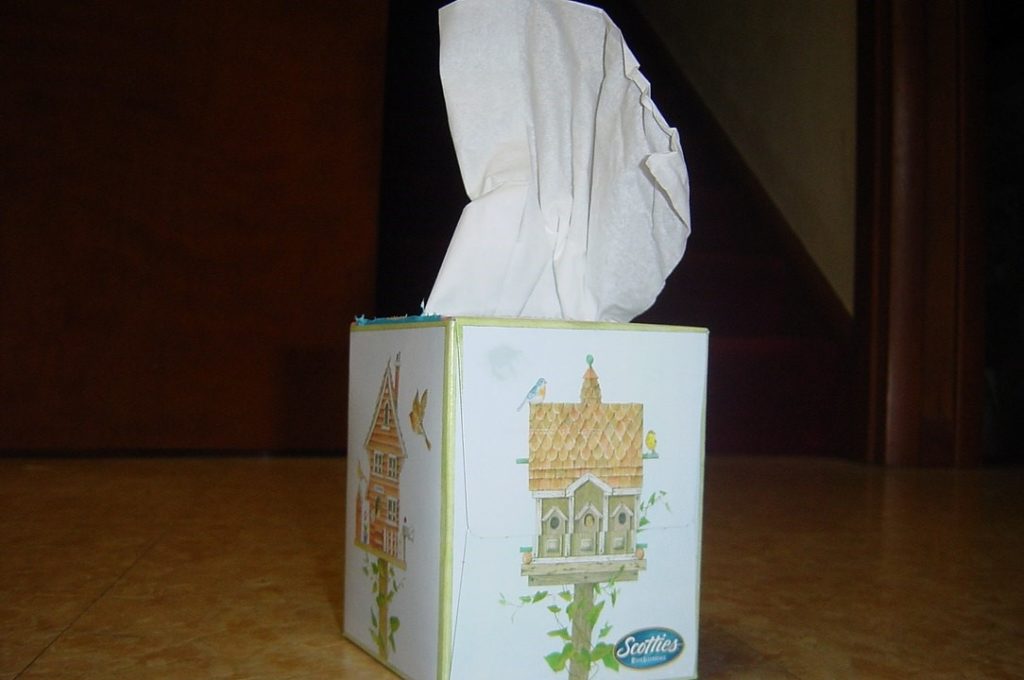
I learned this today. Paper tissues have been used for 1500 years in China, but the modern tissue was invented in 1924.
Paper was invented in China in about 100 BC. A government official called Ts’ai Lun is credited as the person who started the paper-making industry. His paper was made by mixing finely chopped mulberry bark and hemp rags with water. He then pulped it, pressed the water out, and left it dry in the sun. Over the next 600 years, Buddhist monks began to mass produce prayers and wood block printing was invented.
The first reference to paper being used a toilet paper comes from 589 AD. A scholar called Zan Zhitui wrote that he couldn’t use paper with famous quotations on it as toilet paper. Later, in 851 AD, an Arab traveller said that the Chinese do not wash themselves with water, but wipe themselves with paper. These are presumably the first type of tissues. However, the first record of tissues being used to blow noses comes from Japan n the 17th century. People used Japanese tissue paper, which were described as “silky papers, the size of a hand”. They discarded them on the floor after they were used.
Paper spread through Asia but didn’t reach Europe until 1250. Up until then, people bought paper that was made in Egypt or other countries. Even when paper became widespread in Europe, it was still too expensive to be used as tissue paper.
It wasn’t until the Industrial Revolution that it became possible to mass produce paper and the price fell. Until then, most of the work had to be done by hand and watermills could be used to pulp the hemp. A watermill couldn’t get sufficient power to pulp wood, which would make it possible to make large quantities of paper, though. The invention of a steam-driven paper making machine in 1799 changed everything. The invention was improved over the years and by 1844, a machine that took the fibers from wood and made a continuous roll of paper had been invented. The price of paper dropped.
It is no coincidence that the first version of modern roll toilet paper was invented shortly after here, in 1857. Joseph Gayetty invented a way to make thin paper in a roll. It went through many improvements, one of which was to make it splinter free.
Facial tissues couldn’t have been invented without the improvements in toilet paper as the manufacturing process is similar.
Facial tissues were introduced in 1924. They were invented by Kimberly-Clark. Kimberly-Clark was a papermill company started in 1872 by Americans John A Kimberly, Havilah Babcock, and Charles B Clark. I don’t know why Babcock’s name isn’t in there.
Their fortunes changed when they started to manufacture cellu-cotton as a filter for gas masks. It is an absorbent fibrous material made from wood pulp. They came up with a way of micro-folding the paper, which breaks down the rigidity of the paper and increases the volume while making it softer and more absorbent at the same time. It was far more absorbent than regular cotton.
The cotton substitute was also used by the US Army as surgical cotton during World War 1. Nurses also used the cellu-cotton as disposable sanitary pads, and Kimberly-Clark introduced Kotex in response to this.
Kotex wasn’t as popular as the company had hoped, probably due to the embarrassment of having to buy it in a shop. The company decided to make facial tissues out of the same material. They marketed the tissues to women to be used to remove cold cream. They called it Kleenex. “Kleen” because it cleaned your face and “ex” because they were starting to end all of their products with “ex” so they were recognizable.
Kleenex was fairly popular, but the breakthrough came when they started marketing it for colds and hay fever in 1930. The company was getting a lot of feedback that people were using the tissues to blow their noses far more than to remove makeup. Kimberly-Clark went with the flow and sales increased 60%.
The manufacturing of tissues spread all over the world after this and now they are produced in most countries. Many people wouldn’t be able to manage a life without them. Kleenex started the trend and their name has come to mean facial tissues in a lot of countries.
Despite being incredibly helpful, facial tissues make up a huge amount of landfill trash. It biodegrades in about five weeks, but the volume is a problem. Also, the huge amounts of water and chemicals used in the manufacturing process can be harmful to the environment. On top of that, special trees are planted at the expense of natural trees.
So, paper has been around for thousands of years, but the technology to mass produce tissue paper was only invented in the 19th century. Kleenex tissues were introduced in 1924. And this is what I learned today.
Photo CC BY-SA 3.0, https://commons.wikimedia.org/w/index.php?curid=109417620
Sources:
https://www.valmet.com/media/articles/tissue/the-history-of-tissue-products/
https://www.supplytime.com/Blogs/Blog/What-is-the-History-of-Kleenex-Facial-Tissue_111.aspx
https://en.wikipedia.org/wiki/Facial_tissue
https://en.wikipedia.org/wiki/Kimberly-Clark
https://en.wikipedia.org/wiki/Kleenex
https://www.thoughtco.com/history-of-kleenex-tissue-1992033
https://en.wikipedia.org/wiki/Washi
https://en.wikipedia.org/wiki/Japanese_tissue
https://en.wikipedia.org/wiki/Toilet_paper
